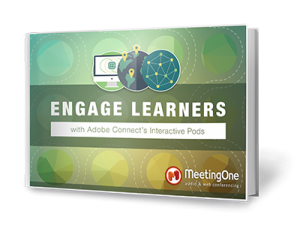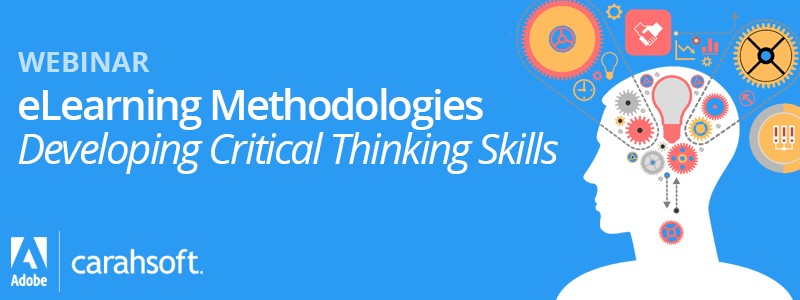Many learners find themselves struggling with online learning programs offered by many businesses.
Why? Too often the emphasis is only placed on skill-building rather than developing a culture of learning. Fostering the desire to learn is what helps online learning programs reach their learners on a deeper level. You could say these programs inspire learners to continue learning.
Leading trainings online, whether the content is delivered on-demand or live, always comes back to a few key ingredients. These components can make your online learning programs a success or leave your learners swimming.
Ensure your time and effort leads to a successful program – Learn how below!
There are four ingredients that impact a learner’s experience with the online setting:
#1. The learning management system (LMS) or virtual classroom they use.
#2. The skill of the instructors.
#3. Effective and proven course material and content.
#4. Engagement-driving spaces for holding live online trainings in virtual classrooms.
The value of some of these factors is a given. Of course, it’s important your instructors be highly capable when delivering content online. And your content certainly needs to be designed to engage learners in the online setting.
Surprisingly, the time and attention paid to selecting the BEST LMSs and virtual classrooms doesn’t always receive the same attention.
Not all LMSs and virtual classrooms are made equal. Depending upon the platforms you use for each, your learners may be having an experience that is negatively impacting their learning.
Making online training more meaningful and connected for learners is the key to foster a culture of learning, which makes for successful online learning programs. What we want to explore today are the technologies that round out the learner experience.
The Tech Behind Successful Online Learning Programs
The Right Learning Management System Strategies
LMS platforms are typically designed to provide instructors the space needed to lead on-demand courses, store course content, and track learner interactions with that material. This model makes up the “traditional eLearning” model.
For all LMS platforms offer, they don’t seem to be delivering to learners’ needs. And traditional eLearning is on a downward trajectory.
We would suggest that an LMS should do more than house courses, content, and reports. An LMS has the potential to be a mover in shaping your company’s learning culture.
There are several leading LMS’s do that go beyond simple course management. In particular, they encourage the following factors that foster an organization-wide love for learning.
Here are five strategies LMS’s use that can have a big impact for successful online programs:
Personalized Learning
In my experience with online learning (it was in healthcare a while back), there was an extent to which the courses I took were entirely defined apart from even the specific needs of my job, let alone my interests. Working in a hospital requires such a rigid learning approach, and I understood this to be the case.
The same should not be true of corporate learners. Their interests are central to their success and retention. These factors translate into increased productivity and loyalty.
In the corporate world, encouraging personalized learning is a must. Initiating personalized plans and learning tracks is a great way to increase a learner’s desire to dig into courses and workplace education.
Of course, you want there to be some structure regarding what they learn. So, to strike that fine balance, you should:
- Discuss with learners their interests and compatible existing courses.
- Establish a flexible learning plan that gives them control over the order and pace in which they take courses.
Having an LMS platform that can utilize flexible course arrangement and options is critical.
Self-enrollment for certifications
Personalized learning is only enhanced when self-enrollment in certification programs is available.
Certification typically expands a learner’s understanding of a topic, and it helps them develop their professional portfolio. Making such certifications available through your LMS is an endearing way to make learning much more than just skill-building.
Gamifying Your Online Learning
Gamification is nothing new, and it’s well known that gamification can benefit online learning. Games that simulate tasks or situations are 90% more likely to translate into information retention.
The mistake many organizations make is to assume gamification requires the literal integration of games into coursework. Gamification should extend to entire platforms.
LMS platforms such as Adobe Captivate Prime take gamification beyond courses. Captivate Prime incorporates badges, leaderboards, personal scoring, and visually striking skill maps to engage learners at every stage of their learning.
These factors do translate:
- 60% of learners are motivated by leaderboards (ibid).
- Badges tend to improve learners’ attitudes.
- Personal scoring can also encourage learners to actively pursue taking more courses.
Annotation
New to some platforms is the availability for learners to annotate content.
Annotation is a unique resource for learners. Annotation gives learners a sense that their opinions and thoughts matter. In turn, those individuals who annotate content take more time to review and understand the content they have been presented. The richness of personal contribution lends itself to helping learners engage content on a deeper level.
Annotation also helps the future learners of your organization. The notes provided by contributing individuals is the best reference an instructor can have for improving their content.
In the long-run, annotation provides a win-win-win: learners feel valued in contributing to content improvement, those same people provide ideal feedback for course refinement, and future learners reap the benefits of content better suited to their needs.
mLearning
Mobile learning (mLearning) is one of those hot buzzwords that’s shaking up the LMS world. And you’d better get with it ASAP.
The simple fact is that learners want to learn on their time and at their convenience. These expectations require educators to make learning accessible no matter where a learner is. mLearning truly embodies the idea of learning whenever and wherever.
Accommodating these needs is fairly easy if you have an LMS that offers mobile compatible courses. Providing mobile compatible courses is not enough alone. Learners may want to continue learning when they don’t have access to Wifi or mobile data.
Consequently, you need to complement mobile compatibility with the opportunity for offline learning.
LMSs that offer mobile compatibility and offline learning opportunities better achieve mLearning.
Virtual Classrooms
An LMS has one shortcoming: alone, it can never bring people together in a “face-to-face,” intimate environment. Supplementing online courses with virtual classrooms has become essential.
Virtual classrooms introduce an immersive setting for learners and instructors to directly engage each other. Bringing virtual classrooms into most LMSs is entirely possible if they are LTI compliant.
If you’re hoping to bring virtual classrooms into your online classes, there are some factors that are of utmost importance:
![]()
LTI Functionality
An LTI is only as good as its functionalities. For a virtual classroom LTI, you want a product that minimally has the following options:
- Single Sign-On to your virtual classroom platform from your LMS.
- The opportunity to create virtual rooms as needed.
- The option to schedule online meetings or virtual classes in advance.
Some virtual classroom LTIs are better than others. Here are the advanced features to look for:
- Generate New Profiles: Make sure the LTI you use has the option to generate user profiles as needed for a course.
- Add Virtual Room to Content in Course: Making your virtual rooms available with content allows learners easier access to virtual classrooms.
- Sync Audio Profiles: Audio integration brings high-quality voice to your virtual classrooms using PSTN related technologies. Make sure your virtual classroom LTI can synchronize the audio profiles associated with your web conferencing platform to your LMS. Syncing up profiles allows users to manage their audio settings from within an LMS.
- Access to Recordings: Recordings can be a great point of reference for learners. Look for an LTI that allows instructors to access the recordings of live virtual classes from your LMS.
(Some LMSs don’t require LTIs to integrate with virtual classrooms. Being part of the same family, Adobe Captivate Prime and Adobe Connect integrate seamlessly without additional technology.)
The above-listed features will help you ensure that your online learning programs are getting the fullest access to virtual classrooms. From there, the ROI of virtual classrooms lies in interactive features and robust analytics.
Interactive Features
Virtual classrooms bring the all-important human element to the online setting. Unfortunately, many virtual classroom platforms only make use of screen sharing, IM, and webcam technologies. A lthough helpful, these three features don’t always ensure you’ll get the interactions you want.
lthough helpful, these three features don’t always ensure you’ll get the interactions you want.
See how interactive features can truly drive interactions with our eBook, “Engage Learners with Adobe Connect’s Interactive Pods.”
Robust Analytics
Online training and learning are possible because most LMS platforms offer comprehensive course analytics. Retrieving stats related to online courses allows businesses a quantitative tool for understanding the success of a course – and the progress of learners.
If you’re going to integrate virtual classrooms into your online learning programs, you’ll want a platform that offers robust analytics. Such platforms keep instructors well informed about the engagement and interest levels of their learners while in a virtual classroom. Creating statistical continuity between online coursework and virtual classrooms is essential for identifying the ROI of online learning programs.
Learn about the analytics offered by Adobe Connect!
Learn more about how Gartner ranked the top virtual classroom platforms on the market – read the full blog!
Find New Ways to Inspire Learners
Fostering a vibrant learning culture should be the end goal of online learning. When learners are engaged, they are more likely to be productive and inspired.
One of the most exciting outcomes of successful online learning programs is the sharpening of critical thinking skills.
Learn how to improve critical thinking across your organization with our webinar recording, “eLearning Methodologies: Developing Critical Thinking Skills.” We explore the important link between online learning, the development of critical thinking skills, and the success of a business.
If you’re looking for an LMS that can help you achieve better practices for online learning, look no further than Adobe Captivate Prime. Designed to make course creation easy, increase learner participation, and provide memorable learning experiences, Adobe Captivate Prime has the tools you need to connect with learners on a deeper level.
Explore Adobe Captivate Prime free for 30 days.
Keep up with every side of online learning – subscribe to our blog!











